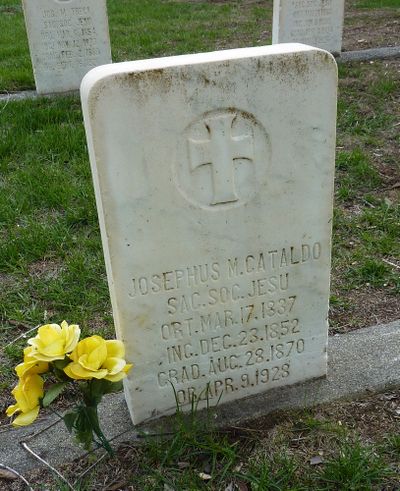Landmarks: Where Jesuits lay to rest

The Jesuit facility at Mount St. Michael was where candidates for the Catholic priesthood in the Society of Jesus order trained from 1916 to 1968, after which it served as a residence for retired priests. But there’s an interesting fact about the site atop a 320-foot high bluff in the Bigelow Gulch area of northeast Spokane. When it was dedicated in 1916, there were already Jesuits in residence.
In his book “Paths to the Northwest: A Jesuit History of the Oregon Province,” the Rev. Wilfred Schoenberg, S.J., wrote: “There is something humorous in the observation that the first Jesuit resident of the Mount was a dead one, Brother Joseph Finello, who died in Spokane on June 24, 1915, and was buried in a temporary grave at the entrance of the new cemetery.”
Indeed some years earlier, a plot of land on the property had been set aside to be the final resting place for priests and brothers of the order, with some being moved there after initial interment in other locations. There is a tall cross at the cemetery with a Latin inscription which translates to “In this place the Society of Jesus carefully cherishes the precious ashes of those whom she bore. They must be given back to heaven.”
The older section of the cemetery is dotted with simple vertical white headstones, with more recent burials having surface markers. There are multiple dates on each – birth, death and the dates when the Jesuit order was entered, ordination and final vows taken. The cemetery is owned by the Jesuits of the Oregon Province, but St. Michael’s Academy and parish just up the hill became the property of the Tridentine Catholic Church in 1977.
Many who were buried in the older section of the cemetery were notable for their roles in bringing Catholicism to Native Americans in the region and for other contributions. For example, the second burial there was in 1916 – the Rev. Etienne De Rouge, who had administered St. Mary’s Mission near Omak and was said to have been well admired on the Colville Indian Reservation because he encouraged tribal members to retain traditional customs and dress. The Rev. Francis Adams, professor of physics at Gonzaga, was buried at the Mount in 1917. In addition to being the driver of Gonzaga University’s first automobile, he did much to quell the public’s anxiety about the appearance in 1910 of Halley’s Comet, telling them that it was to be enjoyed, not feared.
Also buried at the cemetery are the Rev. Adrian Sweere (1911), one of the founders of Seattle University; the Rev. Lawrence Palladino (1927), who worked with tribes in Montana and authored “Indian and White in the Northwest;” the Rev. Louis Taelman (1961), rector/president at Gonzaga, who advocated for construction of the Mount St. Michael scholasticate and under whose tenure Gonzaga became a university and the School of Law was founded; and the Rev. Art Dussault (1991), a vice president at Gonzaga, one of the university’s foremost historians, lifetime friend of Bing Crosby and the man who earned the title “Mr. Gonzaga.”
Schoenberg, considered the dean of Northwest Catholic history and who worked diligently to establish a Native American museum on Gonzaga’s campus, was buried there in 2003.
Three others are important to note as well. In 1920 the body of the Rev. Camillus Imoda, which had been placed in an Army-issue coffin when he died in 1886, was moved from Helena for reburial at the Mount. According to a note in Schoenberg’s book, when the coffin was opened, the body was found to be incorrupt – that is, perfectly preserved. In Catholic tradition, this is a sign of favor by God.
A Jesuit brother, Joseph Giraudi, was diagnosed with cancer of the hip in 1919 and sent to the Jesuit residence at the Mount to prepare for death, as he would not allow his leg to be amputated. According to an account in “Architects of Faith: A History and Tribute to the Builders of Mount St. Michael” by the Sisters of the Congregation of Mary Immaculate Queen, on his death bed in the hospital, he prayed: “If you want me to die; I am ready. But if you want me to do some work, you’ll have to give me back my leg.”
X-rays soon showed the cancer to be gone, and Giraudi went on to build the beautiful Our Lady of Lourdes grotto on the grounds of the parish and continued to beautify the property with assorted flowers and shrubs. He died of a heart attack at age 88 in 1953.
And perhaps the most well-known of the Jesuits buried there is the Rev. Joseph Cataldo, who opened a school at the St. Michael’s Mission and purchased additional land at the site on which the scholasticate would be built. And he convinced Rome that a Catholic college should be built in Spokane – thus he became founder of Gonzaga College in 1887.
According to the Rev. Paul Cochran, S.J., manager of St. Michael’s Cemetery, 600 Jesuit priests and brothers are buried there, and there is room for 75 to 100 more. Located behind a modest gate and sign, it is the final resting place of so many men who devoted their lives in religious service and contributed in significant ways to the educational and spiritual growth of the region.